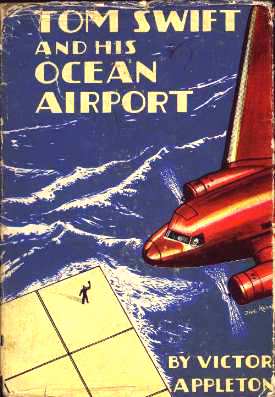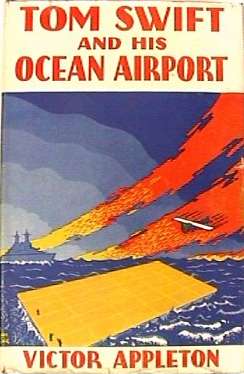
Tom Swift and his Ocean Airport
Or, Foiling the Haargolanders
By Victor Appleton
Summary:
No official summary was ever provided with any of the old Tom Swift books. However, the plot can be summed up as follows:A friend of Tom Swift's was thought to have been murdered over the Atlantic Ocean in an attempt at circling the globe. Tom, partly in memorial and partly because of a need, decides to build a large floating airport out in the middle of the ocean.
To build such an airport requires a very special kind of wood. This wood, called talcap, is imported from the mythical country of Haargoland. There is some trouble getting the wood, but at last Tom gets his wood, figures everything is all right, and goes out to sea to build his airport.
After the airport is built, however, the Haargoland navy shows up and claims the airport for Haargoland, claiming that Tom had no right to take the wood in the first place. Tom then is forced to use his new "soundless wireless" to contact the U. S. Government, which promptly dispatches a large plane and a Navy vessel to the scene.
The Navy vessel, arriving first, promptly forces the Haargolanders to surrender. Before the United States government can take official responsibility for the airbase, however, certain ceremonies have to take place; the men who have to perform these ceremonies are on board the airplane, which gets trapped in a tremendous mid-Atlantic storm.
Can Tom Swift's Ocean Airport stand this ultimate test and save the planeload of diplomats? His Ocean Airport faces its ultimate test!
![]()
Major Inventions

There are two major inventions in this book -- the
soundless wireless and the Ocean Airport. I'll discuss them as they were introduced in the book.
The
soundless wireless is exactly what its name implies it to be -- a wireless (that is, a radio) that makes no noise. Offhand, this doesn't sound like a very great achievement (for those of you out there that are amateur radio operators, how much noise do Ham radios make?), but, according to Tom, the normal wireless is so loud as to "crack your eardrums". Can anyone verify this? Old wireless sets in the movies are always pictured as being silent, efficient monsters -- did they really make that much noise?If they were as loud as Tom claimed, then a quiet wireless would be a nice thing to have -- especially if you wanted to send messages in secret, as Tom did. The invention would hardly be earth shattering, but it would definitely find its place. How he managed this feat is unknown. There are a few vague references to shortening tubes and things like that, but, as usual for his later inventions, no details are supplied.
It is needless for me to say that this invention has found its place in modern life -- modern radio senders are not noisy, loud or irritating. I, to be quite honest, never knew that they were loud, noisy or irritating in the first placeÖ
The other important invention in this book is the
Ocean Airport. The Ocean Airport is exactly what its name implies -- it is an airport that floats around in the middle of the ocean. According to Tom, this invention was needed to give pilots a save haven in the middle of the ocean in case there was a large storm or in case the pilot was having engine trouble. The airport could also be used as an important mid-ocean refueling station -- according to Tom, it was situated 2,000 miles out of the Azores and 2,000 miles away from the nearest land.The Airport was not one large, prefabricated piece, as you can see from the dustjacket. What Tom did was make 36 small perfectly square pieces that, when Tom's giant magnet was activated, would come together to form one large airport. The airport itself was actually manufactured in the middle of the ocean -- the supplies were brought in on board an old Navy vessel and Tom assembled it on-site.
Talcap wood was needed to make the ocean buoyant enough to stay afloat on the ocean. It seemed to possess some rather interesting properties -- it was light, strong, very buoyant, and only grew in revolution-prone Central American countries.
The reason the airport had to be assembled in discreet sections was because the airport was so large that, if it consisted of one large piece, it would be destroyed by the first gale to come its way. This I can heartily believe -- any old, grizzled sailor can tell story after story about the huge force a storm at sea can pack.
It seems that Tom Swift does not have a monopoly on this idea. In the Ted Scott book "Rescued in the Clouds", it mentions the idea of an "ocean airport" and demonstrates the great need for one. Evidently this was a common idea at the time, and quite necessary too -- as dangerous as crossing the ocean was, it would definitely help to have stopping place somewhere.
The great Ocean Airport, while being quite feasible, was, as we all know, never built. The reason is quite simple: aerospace technology has progressed far beyond what anyone in the 1930's would have believed, and nowadays a plane that doesn't have enough range to cross the ocean with some fuel to spare shouldn't be attempting the flight in the first place. Storms that use to be so devastating to earlier pilots can now be entirely missed simply by flying a few thousand feet above the storm. The ocean, for the most part, has been licked.
Update! Some time ago I received an e-mail from someone regarding the soundless wireless. I thought it was very interesting, so after getting permission to post it I am posting it here. Here it is!
I ran across your page while doing some research. I have found memories of
the Tom Swift books. I believe from a third or fourth printing though. Anyway, I had some info for you.
Re then "Soundless Wireless" you reference at http://www.geocities.com/jmkc80/oceanair.html, the original radio
transmitters used a spark-gap technology to send morse code. Each time the key was depressed a spark of electricity was fired across a measured gap
between two electrodes. This created "Hertz" waves that were possible to pick up at a distance.
The original receivers (coherers) used iron filings in a tube. These would realign each time a transmission was received. Then a hammer would bang the
tube with the filings to unalign them again.
Both the spark (which is like a miniature bolt of lightning) and the hammer rearranging the iron filings could have been
noisy. A powerful enough discharge spark to transmit a long distance could have been very
noisy.
Anyway, this may be the origin of Tom ingenious "Soundless Wireless".
Look at http://www.localhistory.scit.wlv.ac.uk/Museum/Engineering/Electronics/history/earlytxrx.htm
for a better source of info on all this.
Thought you would like to know.
![]()
Tom Swift and his Television Detector | Tom Swift and his Planet Stone | Back to the Index